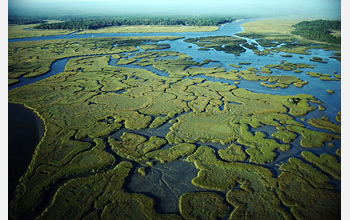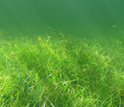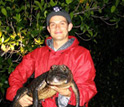News Release 10-133
Gulf Oil Spill: NSF Funds Research on Impacts to Florida Everglades
Extensive seagrass beds, mangrove forests to be studied

NSF has awarded a Gulf oil spill rapid response grant to study the Florida Everglades.
August 4, 2010
This material is available primarily for archival purposes. Telephone numbers or other contact information may be out of date; please see current contact information at media contacts.
With its vast 1.5 million acres of mangrove swamps, sawgrass prairies and subtropical jungles, could the Florida Everglades--the famous river of grass--be affected by the Gulf oil spill?
While current estimates are that little if any oil entered the Loop Current or reached the Everglades, this area is a significant national natural resource, and to study the effects of the spill on seagrasses and mangrove forests in and near the Everglades, the National Science Foundation (NSF) has awarded a rapid response grant to scientists affiliated with NSF's Florida Coastal Everglades Long-Term Ecological Research (LTER) site."
The area is one of 26 such NSF LTER sites around the world.
"The Florida Coastal Everglades LTER site is located within the boundaries of Everglades National Park, an important natural resource," says Todd Crowl, LTER program director in NSF's Division of Environmental Biology, which co-funded the research with NSF's Division of Ocean Sciences.
"This research will document the extent of the spill's impact on the Everglades ecosystem as a whole."
In south Florida, open water, seagrass, and mangrove habitats could receive large amounts of oil and dispersants from the spill, says James Fourqurean of Florida International University (FIU), who was awarded the grant along with Evelyn Gaiser of FIU.
"Oil and dispersants are toxic to marine plants like seagrasses," says Fourqurean, "and mangroves may be smothered and die if oil slicks wash ashore."
The animals that live in these highly productive, diverse ecosystems are also sensitive to toxic compounds in oil and dispersants.
"Significant oil reaching the Everglades could drastically alter marine animal and plant distributions, the structure of the food web, and the cycling of organic matter for years or decades after the spill," says Fourqurean.
In their NSF-funded study, Fourqurean and Gaiser will measure hydrocarbon concentrations and food web structure at sites that may be directly impacted by the oil spill, and assess how these factors change with the arrival of oil.
"This research will discover whether oil spills shorten food chain length in coastal ecosystems, and if food web structure will be affected differently in seagrass beds compared with mangrove forests," says David Garrison, program director for biological oceanography in NSF's Division of Ocean Sciences.
The work will help design future oil spill clean-up efforts, says Gaiser, by defining the fate of oil-derived compounds in seagrass and mangrove ecosystems.
"Ecosystem disturbances due to the oil and dispersants would be difficult to definitively discern," she says, "without an understanding of long-term variability in the system uniquely provided by the LTER program."
The research will also help determine how these compounds influence the food webs that support the economic and cultural infrastructure of the south Florida region, says Fourqurean.
This NSF grant is one of many Gulf oil spill-related rapid response awards made by the federal agency. NSF's response involves active research in social sciences, geosciences, computer simulation, engineering, biology, and other fields. So far, the Foundation has made more than 60 awards totaling nearly $7 million.
-NSF-
-
Dense seagrass meadows on the western edge of Florida Bay support many aquatic animals.
Credit and Larger Version -
Small tidal creeks lined with the roots of red mangroves are especially vulnerable to oil spills.
Credit and Larger Version -
Researchers Bryan Delius and Derek Burkholder take a small sample from a bull shark.
Credit and Larger Version -
Biologist Bill Loftus with a snook, a highly-prized game fish of the mangrove forest.
Credit and Larger Version -
Scientist Adam Rosenblatt holding a young American alligator, a top mangrove forest predator.
Credit and Larger Version
Media Contacts
Cheryl Dybas, NSF, (703) 292-7734, email: cdybas@nsf.gov
Related Websites
NSF LTER Network: http://www.lternet.edu
NSF Florida Coastal Everglades LTER Site: http://fcelter.fiu.edu/
The U.S. National Science Foundation propels the nation forward by advancing fundamental research in all fields of science and engineering. NSF supports research and people by providing facilities, instruments and funding to support their ingenuity and sustain the U.S. as a global leader in research and innovation. With a fiscal year 2023 budget of $9.5 billion, NSF funds reach all 50 states through grants to nearly 2,000 colleges, universities and institutions. Each year, NSF receives more than 40,000 competitive proposals and makes about 11,000 new awards. Those awards include support for cooperative research with industry, Arctic and Antarctic research and operations, and U.S. participation in international scientific efforts.
Connect with us online
NSF website: nsf.gov
NSF News: nsf.gov/news
For News Media: nsf.gov/news/newsroom
Statistics: nsf.gov/statistics/
Awards database: nsf.gov/awardsearch/
Follow us on social
Twitter: twitter.com/NSF
Facebook: facebook.com/US.NSF
Instagram: instagram.com/nsfgov





